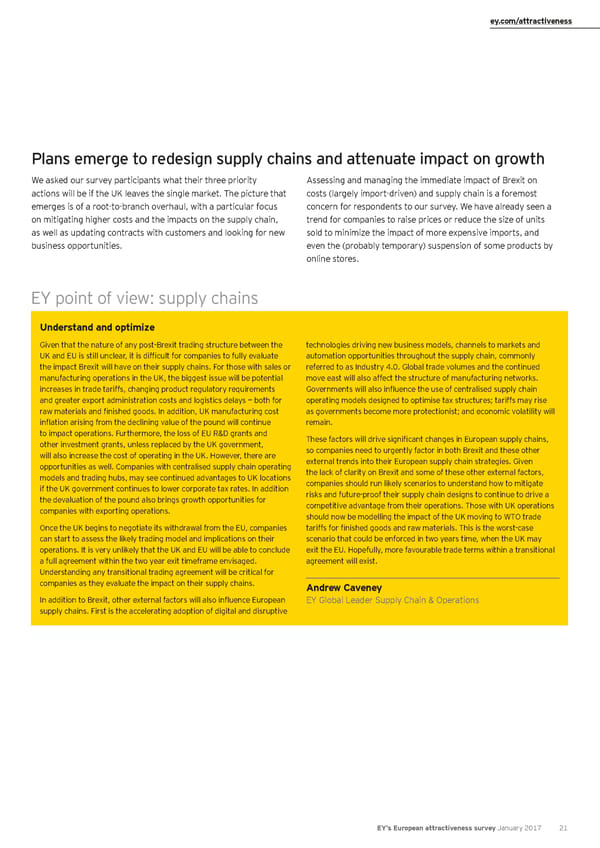ey.com/attractiveness Plans emerge to redesign supply chains and attenuate impact on growth We asked our survey participants what their three priority Assessing and managing the immediate impact of Brexit on actions will be if the UK leaves the single market. The picture that costs (largely import-driven) and supply chain is a foremost emerges is of a root-to-branch overhaul, with a particular focus concern for respondents to our survey. We have already seen a on mitigating higher costs and the impacts on the supply chain, trend for companies to raise prices or reduce the size of units as well as updating contracts with customers and looking for new sold to minimize the impact of more expensive imports, and business opportunities. even the (probably temporary) suspension of some products by online stores. EY point of view: supply chains Understand and optimize Given that the nature of any post-Brexit trading structure between the technologies driving new business models, channels to markets and UK and EU is still unclear, it is difficult for companies to fully evaluate automation opportunities throughout the supply chain, commonly the impact Brexit will have on their supply chains. For those with sales or referred to as Industry 4.0. Global trade volumes and the continued manufacturing operations in the UK, the biggest issue will be potential move east will also affect the structure of manufacturing networks. increases in trade tariffs, changing product regulatory requirements Governments will also influence the use of centralised supply chain and greater export administration costs and logistics delays — both for operating models designed to optimise tax structures; tariffs may rise raw materials and finished goods. In addition, UK manufacturing cost as governments become more protectionist; and economic volatility will inflation arising from the declining value of the pound will continue remain. to impact operations. Furthermore, the loss of EU R&D grants and These factors will drive significant changes in European supply chains, other investment grants, unless replaced by the UK government, so companies need to urgently factor in both Brexit and these other will also increase the cost of operating in the UK. However, there are external trends into their European supply chain strategies. Given opportunities as well. Companies with centralised supply chain operating the lack of clarity on Brexit and some of these other external factors, models and trading hubs, may see continued advantages to UK locations companies should run likely scenarios to understand how to mitigate if the UK government continues to lower corporate tax rates. In addition risks and future-proof their supply chain designs to continue to drive a the devaluation of the pound also brings growth opportunities for competitive advantage from their operations. Those with UK operations companies with exporting operations. should now be modelling the impact of the UK moving to WTO trade Once the UK begins to negotiate its withdrawal from the EU, companies tariffs for finished goods and raw materials. This is the worst-case can start to assess the likely trading model and implications on their scenario that could be enforced in two years time, when the UK may operations. It is very unlikely that the UK and EU will be able to conclude exit the EU. Hopefully, more favourable trade terms within a transitional a full agreement within the two year exit timeframe envisaged. agreement will exist. Understanding any transitional trading agreement will be critical for companies as they evaluate the impact on their supply chains. Andrew Caveney In addition to Brexit, other external factors will also influence European EY Global Leader Supply Chain & Operations supply chains. First is the accelerating adoption of digital and disruptive EY’s European attractiveness survey January 2017 21
 European attractiveness survey January 2017 Page 26 Page 28
European attractiveness survey January 2017 Page 26 Page 28